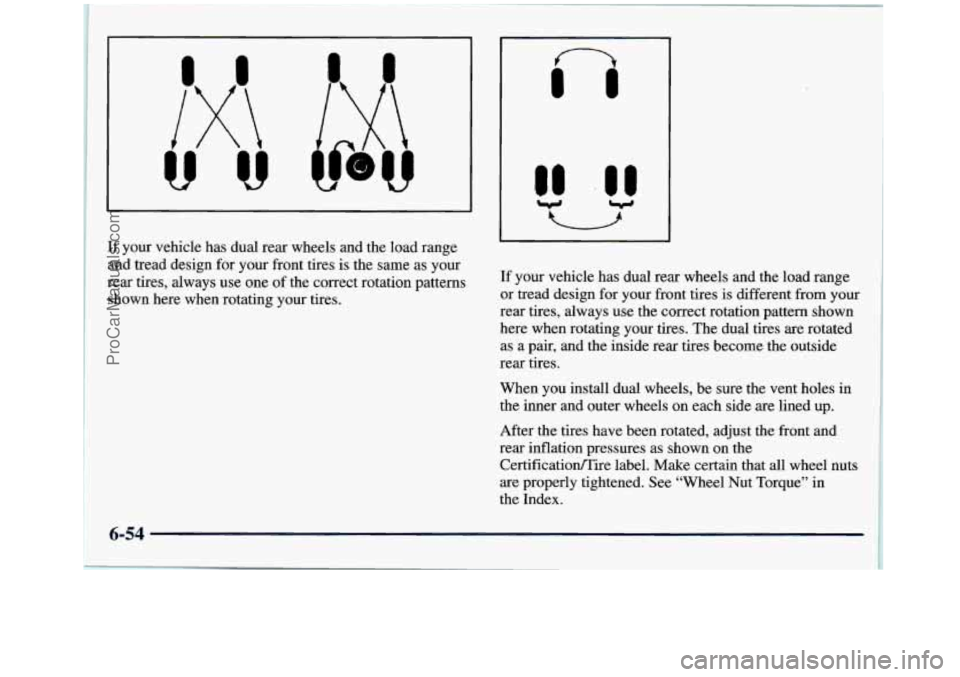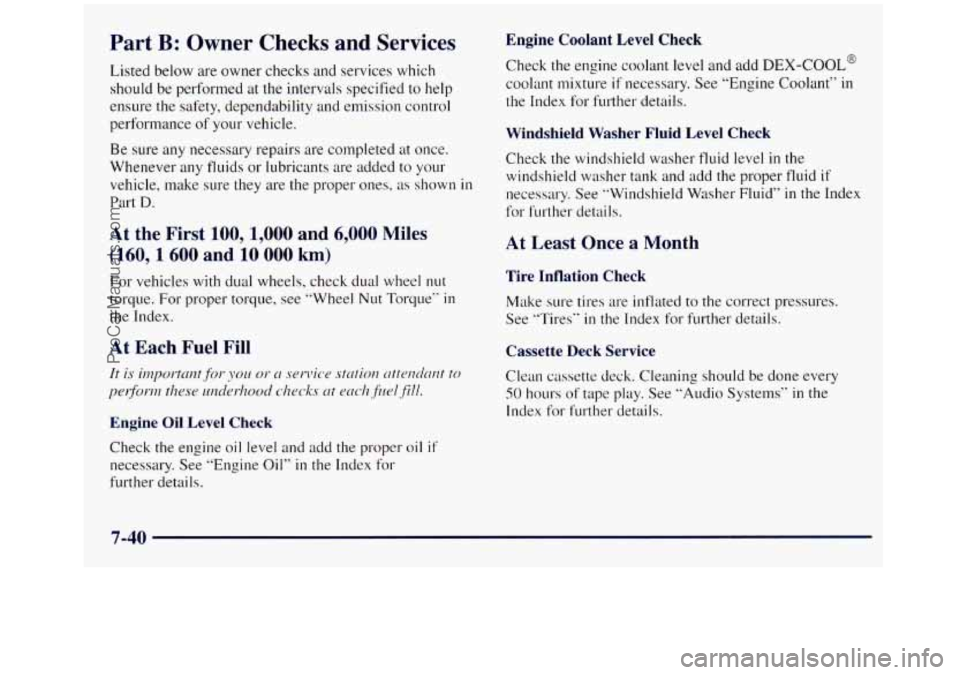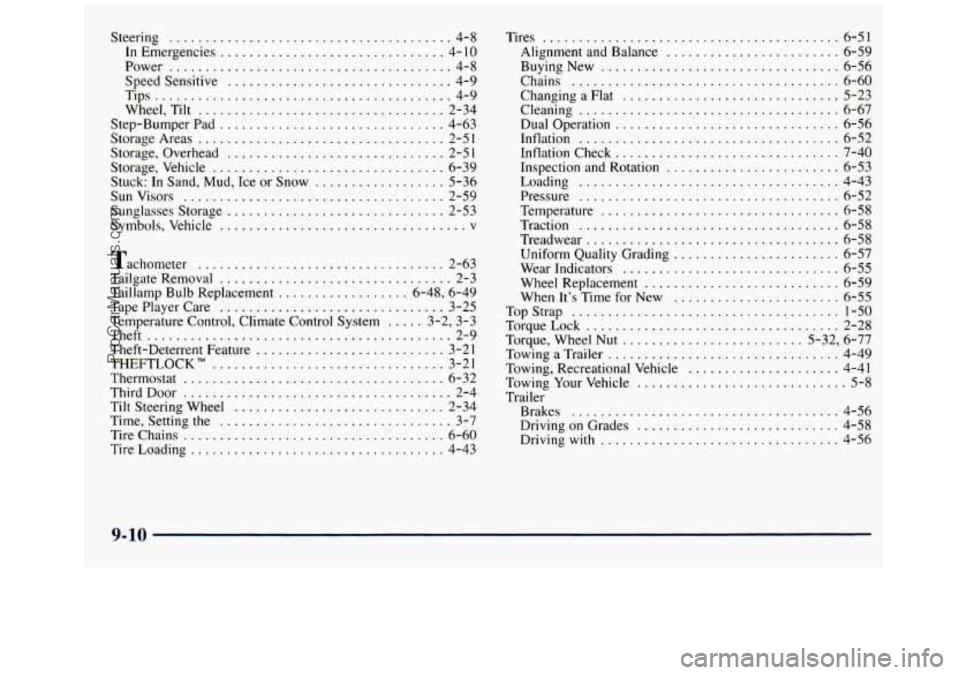1998 GMC SIERRA inflation pressure
[x] Cancel search: inflation pressurePage 231 of 452

Loading Your Vehicle
~EE ~NER'S MANUAL FOR ADDITIONAL INFORMATION. TI
The CertificatiodTire label is found on the rear edge of
the driver's door or in the Incomplete Vehicle Document
in the cab.
The label shows the size of your original tires and the
inflation pressures needed to obtain the gross weight
capacity
of your vehicle. This is called the Gross Vehicle
Weight Rating (GVWR). The GVWR includes the
weight
of the vehicle, all occupants, fuel and cargo.
The CertificatiodTire label also tells you the maximum
weights for the front and rear axles, called Gross Axle
Weight Rating (GAWR).
To find out the actual loads on
your front and rear axles, you need to
go to a weigh
station and weigh your vehicle. Your dealer can help
you with this. Be sure to spread out your load equally on
both sides
of the centerline.
Never exceed the GVWR
for your vehicle, or the
GAWR for either the front or rear axle.
And,
if you do have a heavy load, you should spread
it out.
A CAUTION:
In the case of a sudden stop or collision, things
carried in the bed of your truck could shift
forward and come into the passenger area,
injuring
you and others. If you put things in the
bed of your truck, you should make sure they are
properly secured.
4-43
ProCarManuals.com
Page 342 of 452

Inflation -- Tire Pressure
The CertificationlTire label, which is on the rear edge of
the driver’s door, or on the incomplete vehicle document
in the cab, shows the correct inflation pressures for your
tires when they’re cold.
“Cold” means your vehicle has
been sitting for at least three hours or driven no more
than
1 mile (1.6 krn).
NOTICE:
Don’t let anyone tell you that underinflation or
overinflation is all right.
It’s not. If your tires
don’t have enough
air (underinflation), you can
get the following:
0 Too much flexing
Too much heat
0 Tire overloading
0 Bad wear
Bad handling
0 Bad fuel economy.
If your tires have too much air (overinflation),
you can get the following:
0 Unusual wear
0 Bad handling
0 Rough ride
0 Needless damage from road hazards.
6-52
ProCarManuals.com
Page 344 of 452

~ 11 your
vehicle has dual rear wheels and the load range
’ and tread design for your front tires is the same as your
rear tires, always use one of the correct rotation patterns
shown here when rotating your tires.
r.
If your vehicle has dual rear wheels and the load range
or tread design for your front tires is different from your
rear tires, always use the correct rotation pattern shown
here when rotating your tires. The dual tires are rotated
as a pair, and the inside rear tires become the outside
rear tires.
When you install dual wheels, be sure the vent holes in
the inner and outer wheels on each side are lined up.
After the tires have been rotated, adjust the front and
rear inflation pressures as shown
on the
Certificatioflire label. Make certain that all wheel nuts
are properly tightened. See “Wheel Nut Torque’’ in
the Index.
6-54
ProCarManuals.com
Page 410 of 452

Part B: Owner Checks and Services
Listed below are owner checks and services which
should be performed at the intervals specified
to help
ensure
the safety, dependability and emission control
performance
of your vehicle.
Be sure any necessary repairs are completed at once.
Whenever
any fluids or lubricants are added to your
vehicle, make sure they are the proper ones.
as shown in
Part D.
At the First 100, 1,000 and 6,000 Miles
(160,1600 and 10 000 km)
For vehicles with dual wheels, check dual wheel nut
torque. For proper torque, see “Wheel Nut Torque” in
the Index.
At Each Fue-
Engine Oil Level Check
Check the engine oil level and add the proper oil if
necessary. See “Engine Oil” in the Index for
further details.
Engine Coolant Level Check
Check the engine coolant level and add DEX-COOL@
coolant mixture if necessary. See “Engine Coolant” in
the Index for further details.
Windshield Washer Fluid Level Check
Check the windshield washer fluid level in the
windshield washer tank and add the proper fluid
if
necessary. See ”Windshield Washer Fluid” in the Index
for ElIrther details.
At Least Once a Month
Tire Inflation Check
Make sure tires are inflated to the correct pressures.
See “Tires”
in the Index for further details.
Cassette Deck Service
Clean cassette deck. Cleaning should be done every
50 hours of tape play. See “Audio Systems“ in the
Index for further details.
ProCarManuals.com
Page 444 of 452

Steering ....................................... 4-8
In Emergencies ............................... 4- 10
Power ....................................... 4-8
Speed Sensitive
............................... 4-9
Tips
......................................... 4-9
Wheel’Tilt
.................................. 2-34
Step-Bumper Pad
............................... 4-63
Storage Areas
.................................. 2-5 1
Storage. Overhead .............................. 2-5 1
Storage. Vehicle ................................ 6-39
Stuck: In Sand. Mud. Ice or Snow
.................. 5-36
Sunvisors
.................................... 2-59
Sunglasses Storage
.............................. 2-53
Symbols. Vehicle
.................................. v
Tachometer .................................. 2-63
Tailgate Removal
................................ 2-3
Taillamp Bulb Replacement
.................. 6-48’6-49
Tape Player Care
............................... 3-25
Temperature Control. Climate Control System
..... 3-2. 3-3
Theft
.......................................... 2-9
Theft-Deterrent Feature .......................... 3-2 1
THEFTLOCK” ................................ 3-21
Thermostat
.................................... 6-32
Third Door
..................................... 2-4
Tilt Steering Wheel
............................. 2-34
Time. Setting the
................................ 3-7
Tire Chains
.................................... 6-60
TireLoading
................................... 4-43 Tires
......................................... 6-51
Alignment and Balance
........................ 6-59
BuyingNew
................................. 6-56
Chains
..................................... 6-60
Changing
a Flat .............................. 5-23
Cleaning
.................................... 6-67
Dual Operation
............................... 6-56
Inflation
.................................... 6-52
Inflation Check
............................... 7-40
Inspection and Rotation
........................ 6-53
Loading
.................................... 4-43
Pressure
.................................... 6-52
Temperature
................................. 6-58
Traction
.................................... 6-58
Treadwear
................................... 6-58
Uniform Quality Grading
....................... 6-57
Wear Indicators
.............................. 6-55
Wheel Replacement
........................... 6-59
When It’s Time for New
....................... 6-55
TopStrap
..................................... 1-50
TorqueLock ................................... 2-28
Torque, Wheel
Nut ......................... 5-32, 6-77
Towing
a Trailer ................................ 4-49
Towing, Recreational Vehicle
..................... 4-41
Towing Your Vehicle
............................. 5-8
Trailer Brakes
..................................... 4-56
Driving on Grades
............................ 4-58
Driving with
................................. 4-56
9-10
ProCarManuals.com